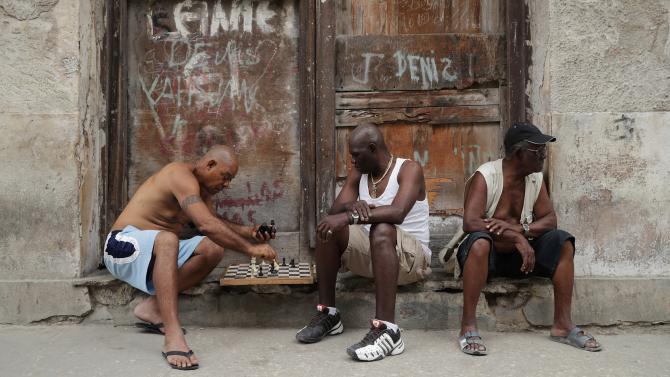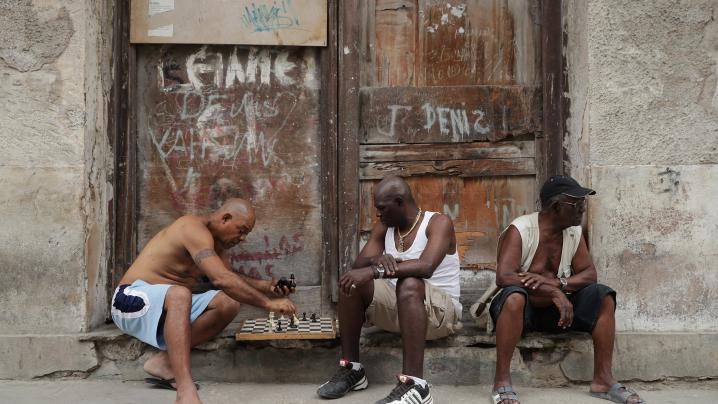[ad_1]

Men play chess in a boarded-up doorway in the historic Old Havana neighborhood of Havana on March 20, 2016.
Chip Somodevilla/Getty Images
On his first day in Cuba, President Barack Obama walked to the center of the Plaza de Armas in the colonial section of Havana to view the imposing marble statue of Carlos Manuel de Céspedes—the George Washington of Cuba’s 19th-century independence movement.
Before he leaves, Obama also should visit a memorial to Antonio Maceo.
In 1868—three years after slavery ended in the United States—Céspedes, a white plantation owner, freed his slaves and urged them to join the revolution he led against Spanish rule of Cuba. The following year, he became the first president of that rebellion, whose constitution called for U.S. annexation of Cuba. The rebellion failed—in part over fear that a black-controlled government might emerge.
Maceo, an Afro-Cuban, was the legendary military leader of that struggle and the later campaign, which ended Spanish rule in 1898. Called the “Bronze Titan,” Maceo was a commander of the interracial army that existed in Cuba around the time when, in the United States, Reconstruction was being dismantled, Black Codes that legitimized decades of Jim Crow practices were being enacted, and the Supreme Court issued its “separate but equal” decision, which justified racial segregation.
Maceo is a major figure in the lost history of the close ties between Afro-Cubans and African Americans that date back nearly 150 years.
In 1872, while Maceo’s interracial army was battling Spanish troops in Cuba, Samuel R. Scottron and James M. Trotter were organizing the Cuban Anti-Slavery Committee in the United States. Scottron was the grandfather of Lena Horne. Trotter was the father of William Monroe Trotter, the black journalist who was kicked out of the White House in 1914 after confronting Woodrow Wilson over the racist practices of his administration.
Slavery didn’t officially end in Cuba until 1886, but in this country, the drumbeat for emancipation was loudest among African-American leaders, including Frederick Douglass, who urged young blacks “to surrender their citizenship to join their fortunes with those of their suffering brethren in Cuba,” Johnnetta Cole wrote in a 1977 Black Scholar article titled, “Afro-American Solidarity With Cuba.”
During the U.S. military occupation of Cuba from 1898 to 1902, it was the American black press that regularly complained about the imposition of “American race prejudice” on the Caribbean island. That racism sparked the creation of an all-black political party inside Cuba in 1908. Its members were largely veterans of the independence war—soldiers who served with Maceo. In May 1912, thousands of them were massacred by Cuban government troops.
For nearly 50 years, a succession of Cuban leaders kept Afro-Cubans mired in an enforced racial caste system that locked them into the bottom of the nation’s political and economic system.
When Fidel Castro first launched the rebellion that brought him to power, he told me during a 1999 dinner meeting, his army was 90 percent black, which he credited to his promise to “give them the equality” that Afro-Cubans earned in the fight to end Spanish rule.
In return, Afro-Cubans have overwhelmingly supported the Castro government. Few have joined the thousands of white Cubans who immigrated to the United States. And many fear that if a large number of those white Cubans return, they will bring back with them the racism that exploited Afro-Cubans.
So, to help allay these concerns, Obama should visit the bust of Antonio Maceo that sits in a tiny park across the street from the Martin Luther King Jr. Memorial Center and Ebenezer Baptist Church in the Marianoa section of Havana—an area that rarely sees a foreign leader or journalist. He should talk to the Rev. Raul Suarez, the church’s pastor, about the disparate impact of the U.S. embargo and some of the well-intentioned actions to roll it back—on Afro-Cubans.
Obama should invite some of Cuba’s leading black intellectuals—people like filmmaker Gloria Rolando, poet Nancy Morejon, academic and civil rights activist Esteban Morales and journalist Gisela Arandia—to join him in the church’s small meeting room to share with him their thoughts about the path ahead for Cuba and its Afro-Cuban majority.
By going to Cuba, Obama has charted a new and exciting direction for U.S.-Cuban relations. But without a full understanding of the complicated interplay between the revolutionaries who seized power in 1959; the mostly white, anti-Castro Cubans in the United States who’ve had a heavy hand in shaping American policy toward the island; and the country’s Afro-Cuban population, Obama will struggle to keep it on course.
[ad_2]






















